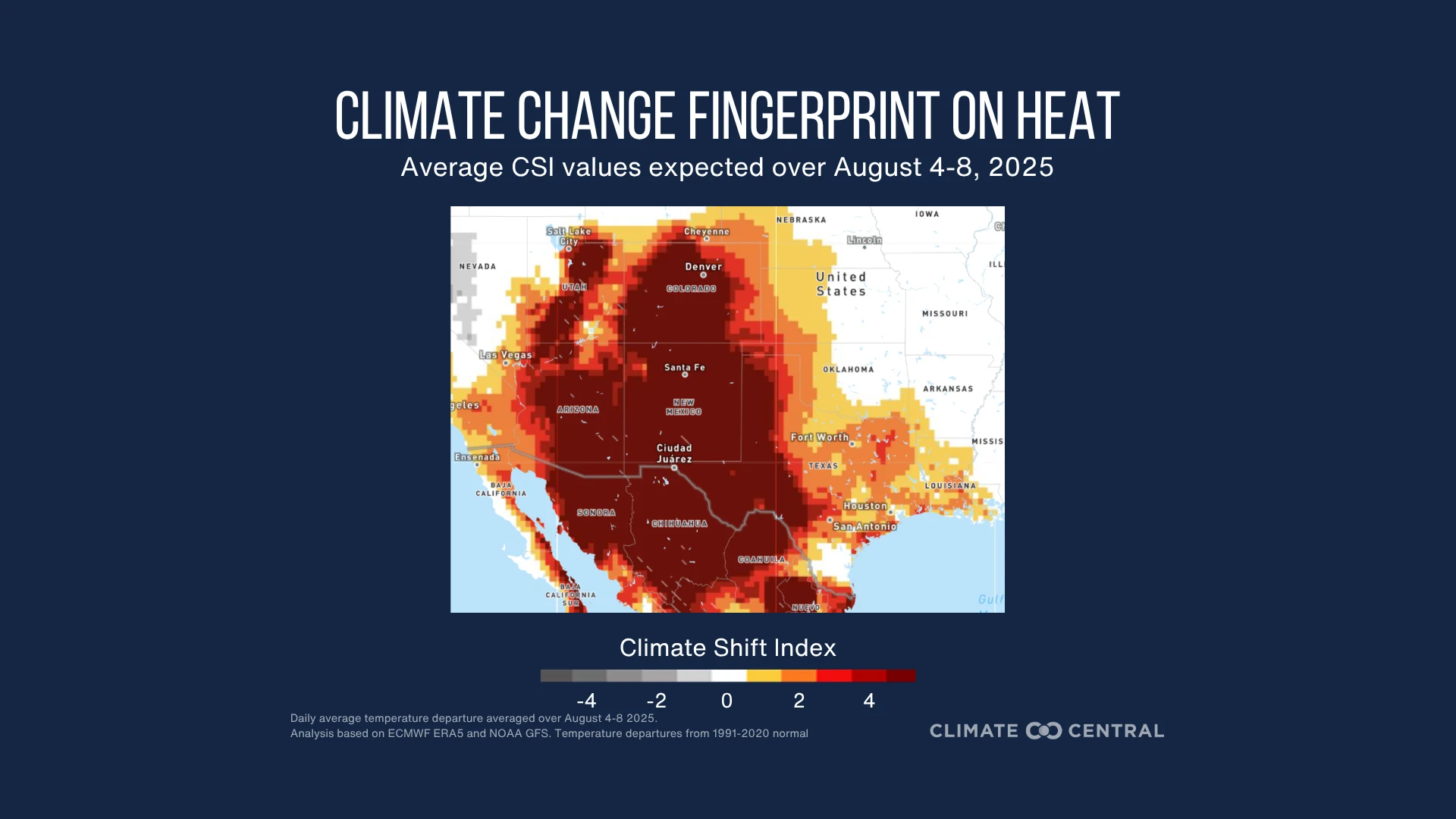Climate Shift Index Alert•August 5, 2025
Extreme heat across the Southwest and Mexico strongly linked to climate change
A prolonged stretch of dangerous heat is forecast across the Southwest U.S. and northern Mexico this week, with temperatures up to 18°F above normal in some areas. Climate Shift Index levels of 5 — the highest possible — indicate that human-caused climate change made this heat at least five times more likely. Nearly 53 million people are expected to experience at least one day under these exceptional, climate-driven conditions.
Note: This event may continue beyond August 8th. Use the Global Climate Shift Index map to stay updated on heat in your region.

How unusual is the forecasted heat?
Daytime highs are forecast to be 8°F to 13°F (4-7°C) above average for this time of year (based on 1991–2020 climate normals) from Aug. 4 through 8, across much of the Southwest, southern Plains, and West — including Arizona, New Mexico, southern California, Nevada, Utah, Colorado, Texas, Oklahoma, and Kansas.
Parts of northern Mexico and Nebraska could see even larger departures from normal, between 15°F to 18°F (8-10°C) during this time.
High temperatures are expected to range from 94°F to 106°F (34-41°C) across much of the region, with even hotter conditions forecast in the desert Southwest. Parts of Southern California, southwest Arizona, southern Nevada, and Sonora (Mexico) could reach between 110°F and 116°F (43 -47°C). The National Weather Service is forecasting moderate to extreme HeatRisk across the region this week.
This heat will persist throughout the week as a strong, upper-level ridge remains anchored over the Southwest and south-central U.S.
There will be little to no relief overnight, as low nighttime temperatures remain elevated — between 87°F and 95°F (31- 35°C) — in southwest Arizona, Southern California, and Sonora. Slightly milder, but still hot, nighttime temperatures between 75°F and 85°F (24-29°C) are expected to impact most of Texas, Oklahoma, New Mexico, Kansas, Nevada, and Chihuahua (Mexico).
Much of this region is facing persistent drought conditions ranging from moderate to exceptional drought. These conditions are drying out the Rio Grande Valley and limiting water availability for agriculture, hydropower, and international trade agreements.
How has climate change influenced this heat?
Climate Shift Index (CSI) levels of 5 — the highest possible — are forecast across the Southwest, southern Plains, Intermountain West, and northern Mexico, meaning human-caused climate change made this extreme heat at least five times more likely. This signals an exceptional climate-influenced event.
Over the full period, nearly 53 million people across the region are expected to experience at least one day with a CSI of 5 or higher, indicating a strong influence from climate change.
What do experts say?
Dr. Zachary Labe, Climate Scientist at Climate Central, said:
“A massive heat dome is building across Northern Mexico and the Southern United States, bringing yet another wave of dangerously high temperatures and little overnight relief for millions. This extreme heat is overwhelmingly likely to be influenced by human-caused climate change, as shown by our Climate Shift Index hitting level 5 — the highest possible on the scale.”
To request an interview with a Climate Central scientist, please contact Abbie Veitch at aveitch@climatecentral.org.
How do we know climate change is influencing this heat?
The Climate Shift Index uses peer-reviewed methodology and real-time data to estimate how climate change has increased the likelihood of a particular daily temperature.
Reporting resources
For quick facts about extreme heat in the U.S. → Extreme Heat Toolkit
For an in-depth guide about how to report on attribution science and extreme weather types → World Weather Attribution’s reporting guide
For the latest research-backed messaging to use while reporting on climate change →Potential Energy’s Guide to Reporting on Unnatural Disasters
